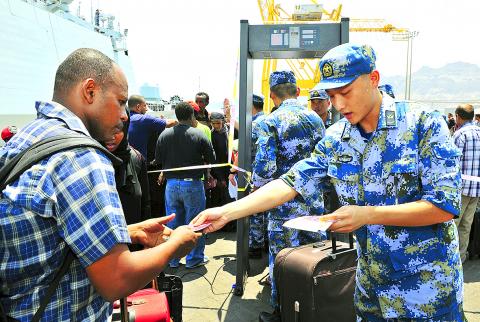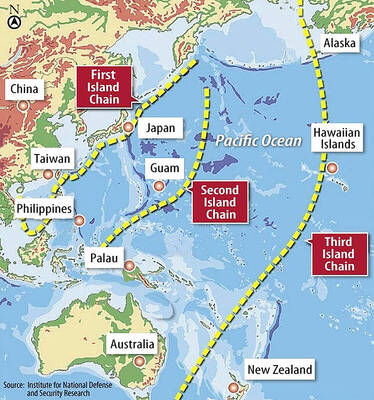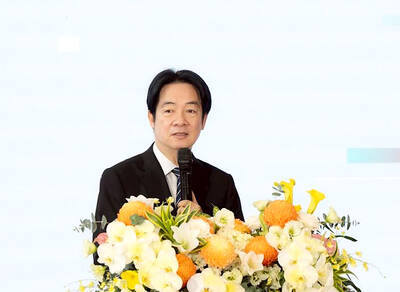The US Office of Naval Intelligence has released a new report on the Chinese People’s Liberation Army Navy (PLAN) saying that its “central priority” is to force the “unification” of Taiwan and China.
Given the pace of Chinese military modernization, the gap in military capability between Beijing and Taipei will continue to widen in China’s favor over the coming years, the report said.
Titled The PLA Navy: New Capabilities and Missions for the 21st Century, the report is the first of its kind issued by US Naval Intelligence in six years.

Photo: Reuters
“In addition to improving the traditional destroyer and frigate backbone of its fleet, the PLAN is on the verge of incorporating very different platforms that will greatly influence the operations of its future fleet,” the report found.
Nuclear-armed Jin-class submarines are poised to begin strategic patrols in the near future, putting Chinese intercontinental ballistic missiles to sea for the first time, it said.
“Against this backdrop of increasing military capability, China’s leaders appear increasingly willing to assert China’s maritime claims, even when such actions risk exacerbating tension with China’s neighbors,” the report said.
Chinese President Xi Jinping (習近平) continues to emphasize the importance of maritime power to enable China’s development, it added.
“Taiwan ‘reunification’ remains the main driver for military modernization,” it said.
According to the report, China views unification with Taiwan as an “immutable long-term goal and hopes to prevent any third party from intervening in what China asserts is an internal matter.”
China’s leaders have long emphasized their preference for peaceful unification, but also say that China is not prepared to wait indefinitely for a political resolution, the report said.
“For several decades, China’s naval investments have focused heavily on capabilities to deter Taiwan’s moves toward independence, to successfully reverse Taiwan’s actions should deterrence fail and — if necessary — to force ‘unification,’ even if the United States were to become militarily involved,” it said.
To achieve unification, the report says that China has built or acquired a wide array of advanced platforms, including submarines, major surface vessels, missile patrol craft, maritime strike aircraft and land-based systems employing new anti-ship cruise missiles and surface-to-air missiles.
China has also developed the world’s first anti-ship ballistic missile, specifically designed to attack enemy aircraft carriers.
“Chinese leaders hope that simply possessing these military capabilities will deter pro-independence moves or — should deterrence fail — permit a range of military options that can be tailored to the specific situation,” the report said.
It concludes that in contrast to its narrow focus of just a decade ago, the PLAN is evolving to meet a wide range of missions, including conflict with Taiwan, enforcement of maritime claims, protection of economic interests as well as counterpiracy and humanitarian missions.
“In the next decade, China will complete its transition from a coastal navy to a navy capable of multiple missions around the world,” the report said.
Although being prepared to “forcibly reunify [sic] Taiwan with the mainland” will remain a “driving force” behind China’s naval modernization, the report says the PLAN is simultaneously focusing resources on a growing array of other challenges.
It says: “Friction between China and its neighbors appears increasingly likely as Beijing seeks to deter rival activities and assert its own claimed rights and interests.”

MISINFORMATION: The generated content tends to adopt China’s official stance, such as ‘Taiwan is currently governed by the Chinese central government,’ the NSB said Five China-developed artificial intelligence (AI) language models exhibit cybersecurity risks and content biases, an inspection conducted by the National Security Bureau (NSB) showed. The five AI tools are: DeepSeek, Doubao (豆包), Yiyan (文心一言), Tongyi (通義千問) and Yuanbao (騰訊元寶), the bureau said, advising people to remain vigilant to protect personal data privacy and corporate business secrets. The NSB said it, in accordance with the National Intelligence Services Act (國家情報工作法), has reviewed international cybersecurity reports and intelligence, and coordinated with the Ministry of Justice Investigation Bureau and the National Police Agency’s Criminal Investigation Bureau to conduct an inspection of China-made AI language

LIMITS: While China increases military pressure on Taiwan and expands its use of cognitive warfare, it is unwilling to target tech supply chains, the report said US and Taiwan military officials have warned that the Chinese People’s Liberation Army (PLA) could implement a blockade within “a matter of hours” and need only “minimal conversion time” prior to an attack on Taiwan, a report released on Tuesday by the US Senate’s China Economic and Security Review Commission said. “While there is no indication that China is planning an imminent attack, the United States and its allies and partners can no longer assume that a Taiwan contingency is a distant possibility for which they would have ample time to prepare,” it said. The commission made the comments in its annual

DETERMINATION: Beijing’s actions toward Tokyo have drawn international attention, but would likely bolster regional coordination and defense networks, the report said Japanese Prime Minister Sanae Takaichi’s administration is likely to prioritize security reforms and deterrence in the face of recent “hybrid” threats from China, the National Security Bureau (NSB) said. The bureau made the assessment in a written report to the Legislative Yuan ahead of an oral report and questions-and-answers session at the legislature’s Foreign Affairs and National Defense Committee tomorrow. The key points of Japan’s security reforms would be to reinforce security cooperation with the US, including enhancing defense deployment in the first island chain, pushing forward the integrated command and operations of the Japan Self-Defense Forces and US Forces Japan, as

‘TROUBLEMAKER’: Most countries believe that it is China — rather than Taiwan — that is undermining regional peace and stability with its coercive tactics, the president said China should restrain itself and refrain from being a troublemaker that sabotages peace and stability in the Indo-Pacific region, President William Lai (賴清德) said yesterday. Lai made the remarks after China Coast Guard vessels sailed into disputed waters off the Senkaku Islands — known as the Diaoyutai Islands (釣魚台) in Taiwan — following a remark Japanese Prime Minister Sanae Takaichi made regarding Taiwan. Takaichi during a parliamentary session on Nov. 7 said that a “Taiwan contingency” involving a Chinese naval blockade could qualify as a “survival-threatening situation” for Japan, and trigger Tokyo’s deployment of its military for defense. Asked about the escalating tensions